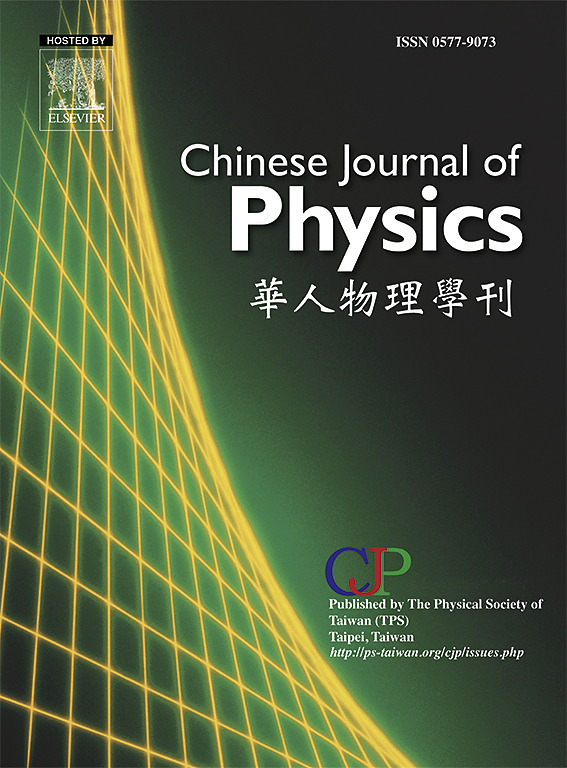Deterministic preparation of GHZ entangled states with multiple superconducting qutrits in circuit QED
IF 4.6
2区 物理与天体物理
Q1 PHYSICS, MULTIDISCIPLINARY
引用次数: 0
Abstract
Over the past decade, several works have been devoted to the generation of entangled states with superconducting (SC) qubits. Recently, attention has shifted to the generation of entangled states with SC qutrits (three-level quantum systems). However, the existing works are limited to the preparation of a maximally entangled EPR pair with two SC qutrits and a Greenberger-Horne-Zeilinger (GHZ) entangled state of three SC qutrits. We here propose a simple method to create a GHZ entangled state of multiple SC qutrits in circuit QED. The GHZ state is generated by employing multiple SC qutrits coupled to a microwave cavity or resonator. This proposal essentially operates by the cavity-qutrit dispersive interaction. By using this proposal, a GHZ state with an arbitrary number of SC qutrits can, in principle, be created. Since only a coupler cavity is utilized, the circuit hardware resources are minimized. No auxiliary energy levels of the qutrits are needed for the entangled state preparation. The GHZ state can be created deterministically. As an example, we analyze the experimental feasibility of preparing a GHZ state of five SC transmon qutrits within current circuit QED technology. This proposal is universal and can be extended to create a GHZ entangled state of multiple matter qutrits (e.g., atomic qutrits, quantum-dot qutrits, NV-center qutrits, Magnon qutrits, and various SC qutrits) by employing multiple natural or artificial three-level atoms coupled to a microwave or optical cavity.

电路QED中多超导量子元GHZ纠缠态的确定性制备
在过去的十年中,一些研究工作致力于超导量子比特的纠缠态的产生。近年来,人们的注意力已经转移到用三能级量子系统产生纠缠态。然而,现有的工作仅限于制备具有两个SC ququits的最大纠缠EPR对和三个SC ququits的greenberger - horn - zeilinger (GHZ)纠缠态。在此,我们提出了一种简单的方法,在电路QED中创建多个SC量子元的GHZ纠缠态。GHZ状态是通过使用多个SC qutrits耦合到微波腔或谐振器而产生的。这一建议基本上是通过空腔-量子色散相互作用来实现的。通过使用该提议,原则上可以创建具有任意数量SC qutrits的GHZ状态。由于只有一个耦合器腔被利用,电路硬件资源被最小化。纠缠态的制备不需要量子阱的辅助能级。可以确定地创建GHZ状态。作为一个例子,我们分析了在现有电路QED技术下制备5个SC发射量子元的GHZ态的实验可行性。该方案是通用的,并且可以扩展到通过将多个自然或人工三能级原子耦合到微波或光学腔来创建多个物质量子(例如原子量子、量子点量子、nv中心量子、马努子量子和各种SC量子)的GHZ纠缠态。
本文章由计算机程序翻译,如有差异,请以英文原文为准。
求助全文
约1分钟内获得全文
求助全文
来源期刊

Chinese Journal of Physics
物理-物理:综合
CiteScore
8.50
自引率
10.00%
发文量
361
审稿时长
44 days
期刊介绍:
The Chinese Journal of Physics publishes important advances in various branches in physics, including statistical and biophysical physics, condensed matter physics, atomic/molecular physics, optics, particle physics and nuclear physics.
The editors welcome manuscripts on:
-General Physics: Statistical and Quantum Mechanics, etc.-
Gravitation and Astrophysics-
Elementary Particles and Fields-
Nuclear Physics-
Atomic, Molecular, and Optical Physics-
Quantum Information and Quantum Computation-
Fluid Dynamics, Nonlinear Dynamics, Chaos, and Complex Networks-
Plasma and Beam Physics-
Condensed Matter: Structure, etc.-
Condensed Matter: Electronic Properties, etc.-
Polymer, Soft Matter, Biological, and Interdisciplinary Physics.
CJP publishes regular research papers, feature articles and review papers.
 求助内容:
求助内容: 应助结果提醒方式:
应助结果提醒方式:


